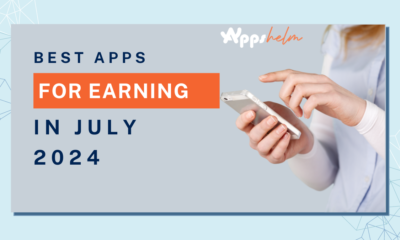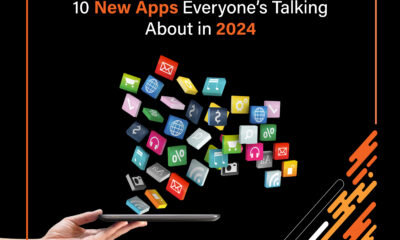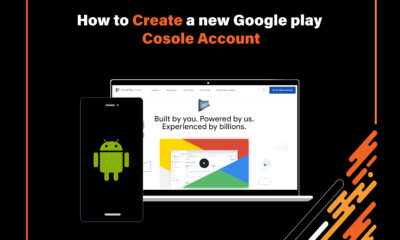App Tips
How to Monetize Your Mobile App Effectively

In today’s digital landscape, mobile apps are not just tools for entertainment or productivity; they are also powerful platforms for generating revenue. However, building an app is just the first step—monetizing it effectively is what ultimately defines its success. With millions of apps vying for users’ attention in app stores, figuring out the right monetization strategy is crucial.
In this article, we’ll dive into various proven strategies to monetize your mobile app effectively, considering user experience, profitability, and long-term growth.
1. Freemium Model: Balancing Free Access with Paid Features
The freemium model is one of the most popular and effective ways to monetize an app. With this approach, users can download and use the basic version of your app for free, while additional features, content, or functionalities are available for purchase.
Why it Works:
- Low Barrier to Entry: Users are more likely to download and try a free app, increasing your user base quickly.
- Value Perception: Offering premium features creates a sense of exclusivity and enhances the perceived value of your app.
- Long-Term Engagement: Once users become invested in your app, they are more likely to pay for enhanced experiences or advanced features.
Examples:
- Productivity apps that offer basic tools for free but charge for advanced features.
- Games that offer extra levels, characters, or power-ups as in-app purchases.
2. In-App Advertising: Earning While Offering Free Access
In-app advertising is another powerful method to generate revenue, especially if your app has a large user base but you want to keep it free to attract even more users. The key to successful in-app advertising is finding a balance between offering ads and maintaining a positive user experience.
Types of In-App Ads:
- Banner Ads: Small ads displayed at the top or bottom of the screen.
- Interstitial Ads: Full-screen ads that appear at natural breaks within the app, like between levels or content sections.
- Rewarded Ads: Users watch ads in exchange for rewards, such as in-game currency or extra features.
Why it Works:
- Consistent Revenue Stream: You can generate income each time an ad is displayed or clicked, offering ongoing revenue without charging users directly.
- Customization: You can tailor ads to match your audience’s interests and habits, making the ads feel less intrusive.
Considerations:
Be mindful of overloading your app with ads. Too many ads, especially intrusive ones, can lead to a poor user experience and cause users to abandon the app.
3. In-App Purchases: Creating Opportunities for Microtransactions
In-app purchases (IAPs) allow users to buy virtual goods, services, or features within the app. This model is widely used in games, but it can also work in other types of apps, such as social media, education, or entertainment platforms.
Types of In-App Purchases:
- Consumable Purchases: Items that users can buy and use once, like extra lives or virtual currency.
- Non-consumable Purchases: Permanent features or items that don’t expire, such as unlocking an ad-free version or additional content.
- Subscriptions: Offering ongoing access to premium features through monthly or yearly payments.
Why it Works:
- Increased User Engagement: IAPs encourage users to keep returning to your app, especially if they’re unlocking new features, levels, or content.
- Revenue Flexibility: By offering both consumable and non-consumable IAPs, you can cater to different types of users, from occasional spenders to power users.
4. Subscription Model: Ensuring Recurring Revenue
The subscription model has become a highly profitable method of app monetization, especially for apps that provide ongoing value, such as content streaming, productivity tools, or fitness apps. Users pay a recurring fee, typically monthly or annually, to access premium features or content.
Why it Works:
- Predictable Revenue Stream: Subscriptions provide consistent, recurring revenue, allowing for better financial planning and scalability.
- Customer Loyalty: When users commit to a subscription, they’re more likely to engage with your app regularly, leading to long-term loyalty.
- High Perceived Value: Users are more inclined to pay for a service they perceive as continuously evolving and offering fresh content or updates.
Examples:
- Video and music streaming apps like Netflix or Spotify.
- News apps or e-learning platforms that offer exclusive content.
5. Sponsorship and Partnerships: Tapping into Business Collaborations
Sponsorship and partnerships involve collaborating with brands or businesses to promote their products or services within your app. This method works best if you have a dedicated user base that aligns with the sponsor’s target audience.
Why it Works:
- Non-Intrusive Monetization: Unlike traditional ads, sponsorships can be integrated naturally within the app, such as branded content, co-hosted events, or sponsored features.
- Higher Revenue Potential: If your app attracts a specific demographic, you can negotiate higher sponsorship fees compared to general advertising rates.
Example:
A fitness app partnering with a sportswear company to promote new products through challenges, rewards, or branded content.
6. Affiliate Marketing: Leveraging External Revenue Streams
Affiliate marketing involves promoting third-party products or services within your app in exchange for a commission on sales or clicks. It’s particularly effective if your app has a strong user base interested in specific niches, such as travel, e-commerce, or fashion.
Why it Works:
- Passive Income: You can generate revenue by recommending products or services without actively developing new features or content.
- Diverse Opportunities: Affiliate programs are available across a wide range of industries, giving you flexibility to choose relevant products or services that resonate with your users.
Example:
A travel app promoting hotel bookings or flight deals, earning a commission for each booking made through the app.
7. Data Monetization: Analyzing and Selling User Insights
While more controversial, data monetization involves collecting and selling anonymized user data to third parties, such as advertisers or market researchers. This method requires transparent privacy policies and ensuring user consent, as privacy concerns are paramount.
Why it Works:
- Valuable Insights: User behavior and data provide companies with insights into customer preferences, enabling more effective marketing strategies.
- Revenue with No Impact on UX: Since data monetization doesn’t directly affect how users interact with the app, it can be an unobtrusive revenue stream.
However, be cautious about privacy regulations, such as GDPR, and ensure you’re following legal guidelines when implementing this strategy.
Conclusion
Monetizing a mobile app effectively is about finding the right balance between profitability and user experience. Whether through the freemium model, in-app purchases, ads, or subscriptions, the key is to align your monetization strategy with your app’s purpose and audience. Always focus on delivering value to your users while ensuring your app generates sustainable revenue.
Experiment with different strategies, track your results, and continually refine your approach to create an app that not only meets your business goals but also provides a seamless experience for your users.
App Tips
Top Fitness Apps to Help You Stay on Track with Your Health Goals

Top Fitness Apps to Help You Stay on Track with Your Health Goals
Maintaining a consistent fitness routine can be a challenge, especially with today’s busy lifestyles. However, fitness apps have emerged as essential tools for anyone looking to achieve their health and fitness goals. From tracking workouts and meals to offering personalized coaching and motivation, these apps make it easier than ever to stay on track. Whether you’re looking to lose weight, build muscle, or simply stay active, there’s a fitness app that fits your needs. In this article, we’ll explore the top fitness apps available today and how they can help you achieve your health goals.
1. MyFitnessPal: Best for Tracking Nutrition and Exercise
MyFitnessPal is one of the most popular and comprehensive fitness apps on the market, known for its robust calorie and nutrition tracking features. Whether you want to lose weight, maintain your current weight, or gain muscle, this app can help you stay on track by tracking both your food intake and exercise.
The app boasts a massive database of over 11 million foods, making it easy to log meals by scanning barcodes or manually entering ingredients. It also allows you to track macronutrients like carbohydrates, proteins, and fats, which is particularly helpful if you’re following a specific diet plan. Beyond nutrition, MyFitnessPal integrates with various fitness trackers and devices to monitor your activity levels, making it a comprehensive tool for managing both diet and exercise.
Key Features:
- Extensive food and exercise database
- Barcode scanning for quick meal logging
- Integration with other fitness apps and devices
- Detailed nutritional insights and goal tracking
2. Nike Training Club: Best for At-Home Workouts
Nike Training Club is a versatile fitness app that offers free, on-demand workouts ranging from beginner to advanced levels. Whether you’re interested in strength training, cardio, yoga, or mobility exercises, Nike Training Club has a wide variety of workout plans designed by professional trainers.
The app includes workouts for different fitness goals, such as improving endurance, toning muscles, or losing weight. Each session comes with step-by-step guidance, video demonstrations, and progress tracking. One of the standout features is its personalized workout recommendations based on your activity and goals. Nike Training Club also offers targeted programs that last four to six weeks, ideal for users who want a structured fitness plan.
Key Features:
- Wide range of workouts (strength, cardio, yoga, etc.)
- Guided routines from professional trainers
- Personalization based on user goals
- Customizable workout plans
3. Fitbit: Best for Tracking Daily Activity
For those who already own a Fitbit device, the Fitbit app is a powerful companion that tracks daily activities like steps, heart rate, sleep, and workouts. The app is designed to help users reach their fitness goals by offering real-time data on daily activity levels and long-term trends. It can track everything from the number of steps taken each day to calories burned and even the quality of your sleep.
One of Fitbit’s biggest advantages is its ability to monitor your overall well-being. It tracks not only your fitness levels but also your sleep patterns and heart rate variability, providing insights into how well your body is recovering and functioning. The app’s community features also allow users to join challenges and compete with friends, adding an element of motivation and accountability.
Key Features:
- Detailed tracking of steps, heart rate, and sleep
- Integration with Fitbit wearable devices
- Community challenges and leaderboards
- Personalized insights based on activity levels
4. Strava: Best for Runners and Cyclists
Strava is a go-to fitness app for runners, cyclists, and outdoor enthusiasts. It tracks routes, distance, pace, and elevation using GPS and offers detailed performance analytics after each workout. Strava is popular among athletes who want to track their progress over time, set personal records, and compare their performance with other athletes in their area.
One of the unique features of Strava is its social component. Users can join clubs, share their workouts, and compete on leaderboards, which can be highly motivating. Whether you’re training for a marathon or just enjoying a casual bike ride, Strava’s robust data tracking and analytics make it an excellent tool for both serious athletes and recreational fitness enthusiasts.
Key Features:
- GPS tracking for running, cycling, and hiking
- Detailed analytics on pace, distance, and elevation
- Social features, including clubs and leaderboards
- Integration with wearables and fitness devices
5. Calm: Best for Mental Fitness and Mindfulness
While physical fitness is important, mental well-being plays an equally vital role in achieving overall health goals. Calm is a mindfulness and meditation app designed to help users reduce stress, improve sleep, and cultivate mental resilience. With guided meditations, breathing exercises, and sleep stories, Calm offers tools that complement your physical fitness efforts by focusing on mental fitness.
The app also offers mindfulness programs tailored to specific goals, such as improving focus, reducing anxiety, or enhancing overall happiness. For those struggling with sleep, Calm’s sleep stories and music can help you unwind and get better rest, which is essential for recovery and performance in physical fitness.
Key Features:
- Guided meditations and mindfulness exercises
- Sleep stories and relaxation music
- Breathing exercises to reduce stress
- Customizable mindfulness programs
6. JEFIT: Best for Strength Training
JEFIT is a fitness app tailored for those focused on strength training and bodybuilding. It offers thousands of workout routines for all fitness levels, along with detailed instructions and tracking features for every exercise. JEFIT also allows you to log your workouts, track your progress, and measure improvements in strength over time.
The app includes a workout planner that helps you create a customized workout routine based on your goals, whether you’re looking to build muscle, lose fat, or improve endurance. With JEFIT, you can easily track weights, reps, and sets, making it a great tool for anyone serious about resistance training.
Key Features:
- Workout tracking for strength training and bodybuilding
- Pre-made workout routines and customizable plans
- Progress tracking for strength and muscle growth
- Detailed exercise instructions and demonstrations
Conclusion: Achieving Your Fitness Goals with the Right App
In today’s digital age, fitness apps have become invaluable tools for anyone looking to stay on track with their health and wellness goals. Whether you’re interested in improving your nutrition, staying active at home, or tracking your daily movements, there’s an app that can meet your specific needs.
Apps like MyFitnessPal and Fitbit offer comprehensive tracking, while Nike Training Club and JEFIT provide structured workout plans to guide your fitness journey. Meanwhile, apps like Calm ensure that you’re focusing on mental fitness alongside physical health. No matter your fitness level or goals, these top fitness apps can help you stay motivated, organized, and on track toward a healthier lifestyle.
App Tips
How to Optimize Your App Store Listing for Higher Visibility and Downloads

Creating a high-quality app is only half the battle in the competitive world of mobile applications. To ensure your app reaches its full potential, optimizing your app store listing is essential for higher visibility and downloads. App Store Optimization (ASO) is a systematic approach to improving your app’s ranking and visibility within an app store like Google Play or Apple’s App Store. In this article, we’ll explore key strategies and best practices to effectively optimize your app store listing and attract more users.
1. Choose the Right App Name and Title
Your app’s name is the first impression users get, and it plays a crucial role in ASO. The name should be unique, memorable, and reflect the app’s primary function or purpose. Here are a few tips for creating an effective app name:
- Use Relevant Keywords: Include high-ranking keywords in the title, as both Google Play and Apple’s App Store consider the app title in their search algorithms. For example, if you have a fitness app, include words like “fitness,” “workout,” or “training.”
- Keep It Short and Simple: While using keywords is important, don’t stuff them. Ensure the name is concise and doesn’t exceed character limits (30 characters for Apple’s App Store and up to 50 for Google Play).
- Avoid Unnecessary Symbols: Stick to alphabets and numerals. Special symbols can look spammy and reduce readability.
Example: Instead of a vague name like Pro Health, use Pro Health: Fitness & Workout App to make it keyword-rich and descriptive.
2. Optimize Your App’s Description
The description should provide a clear, compelling overview of your app and its features. This section is particularly important on Google Play, as its search algorithm considers keywords within the description. For Apple’s App Store, it’s less impactful for rankings but crucial for convincing users.
Key Tips:
- First Few Lines Matter: Focus on the first 252 characters, as this is what users see without expanding the description. Include key features, benefits, and a call to action.
- Bullet Points for Clarity: Use bullet points to highlight main features and make the text scannable.
- Include Keywords Naturally: Mention high-ranking keywords, but maintain a natural flow to avoid keyword stuffing.
- Update Regularly: Keep your description up-to-date with new features, user testimonials, and achievements to show continuous improvement.
Example of an effective opening:
“Achieve your fitness goals with Pro Health! Track workouts, monitor your progress, and follow personalized training plans. Download now and start your journey towards a healthier lifestyle!”
3. Leverage High-Quality App Icons
The app icon is a visual representation of your app and plays a significant role in driving clicks and downloads. A well-designed icon can make your app stand out in search results and entice users to explore further.
Best Practices:
- Keep It Simple and Relevant: Avoid clutter. Your icon should be a simple, recognizable symbol of your app’s purpose.
- Use Bold Colors: Bright, bold colors grab attention but ensure they don’t overwhelm. Maintain contrast between the background and the symbol.
- Stay Consistent with Your Brand: Use colors, shapes, and styles that align with your app’s branding to create a cohesive look.
For example, a minimalist design works well for utility apps, while games may benefit from vibrant and dynamic icons.
4. Choose the Right Screenshots and Videos
Visual elements like screenshots and videos are vital for showcasing your app’s features. They help users understand the app’s interface, usability, and unique selling points. Use this space strategically to convince potential users to download.
Tips for Effective Screenshots:
- Highlight Core Features: The first two screenshots should showcase the app’s most attractive and useful features.
- Use Captions: Add short, descriptive text overlays to highlight key functionalities or user benefits.
- Show the App in Action: Use real, in-app images that demonstrate the app’s user experience and interface.
Videos:
- Keep it Short: A 15-30 second video is enough to convey your app’s value.
- Focus on Visuals: Don’t rely heavily on text. Make sure the visuals clearly communicate the app’s primary features.
5. Use the Right Keywords
Keyword optimization is a cornerstone of ASO. Using the right keywords improves your app’s searchability and ranking.
Keyword Research Tips:
- Analyze Competitors: Use tools like Sensor Tower, App Annie, or Keyword Tool to analyze what keywords top competitors are using.
- Use Long-Tail Keywords: Long-tail keywords (e.g., “best home workout app”) are less competitive and can drive more targeted traffic.
- Monitor and Adjust Regularly: ASO is an ongoing process. Keep track of keyword rankings and update them based on performance.
6. Gather Positive Ratings and Reviews
Ratings and reviews are a crucial factor in both app stores’ ranking algorithms. Apps with higher ratings and positive reviews rank better and appear more credible to users.
Strategies for Gathering Reviews:
- Prompt Users at the Right Time: Ask for a review after a positive experience, like completing a level in a game or using a feature successfully.
- Respond to Reviews: Address negative reviews professionally and thank users for positive feedback.
- Incentivize Feedback: Offer small in-app rewards or exclusive content to users who leave a review.
7. Localize Your App Store Listing
Localization involves adapting your app store listing to cater to different languages and regions. It can significantly boost visibility and downloads in non-English-speaking markets.
How to Localize:
- Translate the App Title and Description: Ensure translations are accurate and contextually relevant.
- Adapt Visuals and Screenshots: Modify screenshots to reflect local culture and language where necessary.
- Use Local Keywords: Research and implement local keywords to target specific regions effectively.
8. Optimize for App Store Algorithm Updates
Both Google Play and Apple’s App Store frequently update their ranking algorithms. Stay informed about changes and adjust your ASO strategy accordingly.
- Keep Track of Industry Updates: Follow ASO communities and forums like ASO Stack and Google Developer Blog.
- A/B Test Regularly: Experiment with different titles, descriptions, and visuals to determine what works best.
Conclusion
Optimizing your app store listing is an ongoing process that requires a combination of keyword research, visual appeal, and user engagement strategies. By implementing these best practices, you can improve your app’s visibility, attract more potential users, and ultimately increase downloads. Remember, success in the app stores is about creating a great first impression and delivering a compelling reason for users to choose your app over the competition.
App Tips
10 Ways to Improve Your App’s Battery Efficiency

Battery efficiency is a critical aspect of any mobile application. Users are quick to notice when an app drains their device’s battery, and this can significantly impact the app’s retention and ratings. With increasing competition and user expectations, optimizing battery usage is essential for app developers looking to create high-quality, user-friendly applications. In this article, we’ll explore 10 practical strategies to improve your app’s battery efficiency, ensuring a smoother experience for your users.
1. Optimize Background Processes
One of the most common reasons for excessive battery usage is background processes that continuously run even when the app is not in active use. Reducing or optimizing these background operations is key to conserving battery life. Techniques to achieve this include:
- Using background scheduling techniques like JobScheduler (Android) or BackgroundTasks (iOS) to handle non-urgent tasks.
- Limiting background services or transitioning to WorkManager (Android) for managing deferrable background jobs.
- Implementing smart algorithms to decide when and if background tasks should run based on user activity.
By minimizing unnecessary background processing, you reduce battery consumption and ensure the app is only active when it needs to be.
2. Implement Efficient Network Usage
Network operations, especially data transfers, are some of the biggest culprits behind battery drain. Consider optimizing network requests to minimize battery usage:
- Use batching to combine multiple network requests into a single one, reducing the number of times the device has to establish a connection.
- Cache frequently accessed data locally to avoid redundant network calls.
- Implement progressive loading so that resources like images or videos load in chunks rather than all at once.
- Consider using HTTP/2 for more efficient data transfer.
Reducing the number of network requests and optimizing how data is transferred can significantly improve the app’s overall efficiency.
3. Reduce Location Updates and Use Geo-Fencing
Location services are notorious for consuming high levels of battery. Using continuous GPS tracking can quickly drain a device’s battery, especially if the app requires frequent updates.
To optimize battery consumption, try the following:
- Use geo-fencing instead of continuous GPS updates to trigger location-based actions.
- Switch to low-power location providers (such as Wi-Fi or cell tower triangulation) when high accuracy isn’t necessary.
- Use passive location listeners to receive updates only when other apps or system services request location updates.
Implementing these practices will minimize the power drain associated with location tracking while maintaining essential functionality.
4. Manage Wake Locks and Avoid Unnecessary CPU Usage
A wake lock is a mechanism that prevents the device’s CPU from entering a sleep state. While wake locks are sometimes necessary, misusing them can lead to excessive battery drain.
- Use partial wake locks only when absolutely required and ensure they are released promptly.
- Avoid wake locks for tasks that don’t require constant CPU attention.
- Use JobScheduler and AlarmManager to schedule tasks that can run when the CPU is already awake.
Properly managing wake locks will help ensure that your app doesn’t unnecessarily keep the CPU running, which conserves battery life.
5. Optimize Animation and UI Rendering
Smooth animations and visually appealing UI elements are great for user experience, but they can also be a drain on the battery if not implemented correctly. Techniques for optimizing UI rendering include:
- Limiting the use of complex animations and keeping frame rates balanced.
- Avoiding heavy graphics processing, such as continuous rendering of 3D objects or complex image manipulations.
- Using hardware acceleration where possible to offload rendering to the GPU.
Optimizing the app’s UI and animations ensures that the device doesn’t expend more energy than necessary to display the user interface.
6. Efficient Use of Sensors
Modern smartphones come with various sensors, such as accelerometers, gyroscopes, and proximity sensors, which can enhance app functionality. However, these sensors can also quickly consume battery power if used incorrectly.
- Avoid keeping sensors active for long periods.
- Use sensor batching to reduce the number of times sensor data is sent to the app.
- Implement event-based triggers instead of continuous monitoring.
Managing sensor activity carefully can prevent unnecessary energy drain, particularly in apps that rely heavily on motion or environmental data.
7. Use Push Notifications Instead of Polling
Polling is the process of repeatedly checking a server for new information, which is highly inefficient. Replacing polling with push notifications can dramatically reduce the frequency of network activity and conserve battery life.
- Implement silent push notifications to trigger data updates only when necessary.
- Use Firebase Cloud Messaging (FCM) for Android or Apple Push Notification Service (APNs) for iOS for delivering lightweight notifications.
- Avoid frequent polling by setting appropriate update intervals.
Push notifications ensure that the app only wakes up when there’s new information to display, saving significant amounts of battery power.
8. Optimize Power-Intensive Features
Power-intensive features like video playback, voice recognition, or image processing can quickly drain battery life. Optimize these features by:
- Implementing power-saving modes for heavy features (e.g., lowering frame rates during video playback).
- Compressing images and videos to reduce processing time.
- Offloading complex processing tasks to the server, where applicable.
Balancing feature performance with power consumption will prevent these capabilities from being a drain on the user’s battery.
9. Use Adaptive Battery Features
Both Android and iOS have introduced adaptive battery features designed to identify and limit power-hungry apps. Developers should leverage these system-level optimizations:
- For Android, use the App Standby Buckets API to inform the system of the app’s battery priorities.
- Implement iOS’s Background Fetch and Background Refresh mechanisms to reduce battery impact.
- Use Doze Mode and App Standby to manage how often your app runs in the background.
Integrating these features ensures that the operating system can intelligently manage the app’s battery usage.
10. Regularly Monitor and Optimize Battery Usage
Finally, regularly analyzing your app’s battery consumption is crucial for identifying areas that need improvement. Use built-in tools like:
- Android Studio Profiler and Xcode’s Energy Log to measure battery usage and optimize accordingly.
- Employ analytics and crash-reporting tools to identify performance issues and excessive battery drain.
- Gather user feedback to understand real-world performance and make adjustments.
Regular monitoring and optimization will help ensure that your app remains battery-efficient as new updates and features are introduced.
Conclusion
Improving your app’s battery efficiency requires a multi-faceted approach, from managing background processes to optimizing UI animations and leveraging system-level features. By implementing these 10 strategies, you can create an app that not only delivers excellent performance but also conserves energy, providing a better experience for your users and boosting your app’s overall reputation. With a focus on battery efficiency, your app can stand out in a competitive market where performance and user satisfaction are paramount.
-

 App Tips5 months ago
App Tips5 months agoBest Alternative Keyboard Apps
-

 App News5 months ago
App News5 months agoGoogle Confirms Play Store Update
-

 Recommendation5 months ago
Recommendation5 months agoBest Apps for Earning in July 2024
-

 App Reviews2 months ago
App Reviews2 months ago10 New Apps Everyone’s Talking About in 2024
-

 Uncategorized2 months ago
Uncategorized2 months agoThe Hottest New AI Apps You Should Try Today
-

 How To3 months ago
How To3 months agoHow to create a new Google Play console account
-

 Entertainment5 months ago
Entertainment5 months agoBest Android Game App of July 2024
-

 App Reviews5 months ago
App Reviews5 months agoThese VPN Apps Can Help Improve Your Online Privacy




